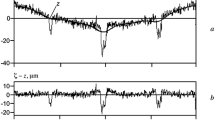Abstract—
Monitoring roughness parameters of friction surfaces is critical to ensuring the operational properties of tribosystems. These values largely depend on the accuracy with which surface roughness is extracted from the primary surface profile. A method of surface profile filtration is proposed. This method based on decomposition of the primary profile into empirical modes enables an increase in the accuracy with which surface roughness parameters are estimated. A corresponding technique has been developed and an algorithm has been proposed for extracting roughness, waviness, and form profiles and determining the mean line for surface roughness using empirical mode decomposition. The algorithm is implemented in the MATLAB programming environment. The proposed method is compared against Gaussian filtration and wavelet filtration in extracting the mean line and arithmetic mean deviations for the roughness profile of simulated and actual (milled and grinded) surfaces. The method of empirical mode decomposition is shown to yield the mean line for the simulated profile maximally coinciding with the theoretical one. In addition, the proposed method introduces minimal edge distortions, which enables extraction of the surface roughness profile virtually reproducing the theoretical profile. The value of the arithmetic mean deviation is the closest to that calculated based on the theoretical roughness profile. It is determined that the mean line constructed using the method of decomposition into empirical modes more accurately reflects the change in the primary profile of the milled and grinded surfaces in the long-wavelength region. This ensures a higher accuracy of the calculated surface roughness parameters. The proposed filtration method based on the decomposition of the primary profile into empirical modes is intended for determining the roughness parameters of engineering surfaces, including digital profilometers.



Similar content being viewed by others
REFERENCES
Demkin, N.B., Kachestvo poverkhnosti i kontakt detalei mashin (Surface Quality and Contact of Machine Parts), Moscow: Mashinostroenie, 1981.
Grigor’ev, A.Ya., Fizika i mikrogeometriya tekhnicheskikh poverkhnostei (Physics and Microgeometry of Technical Surfaces), Minsk: Belorusskaya Nauka, 2016.
Rudzit, Ya.A., Mikrogeometriya i kontaktnoe vzaimodeistvie poverkhnostei (Microgeometry and Contact Interaction of Surfaces), Riga: Zinatne, 1975.
Huang, N.E., et al., The empirical mode decomposition and the Hilbert spectrum for nonlinear and non-stationary time series analysis, Proc. R. Soc. London, Ser. A, 1998, vol. 454, pp. 903–995.
Vit, J., Surface metrology open profile Gaussian filter. https://www.mathworks.com/matlabcentral/fileexchange/ 52892-surface-metrology-open-profile-gaussian-filter. Cited February 15, 2021.
D’yakonov, V.P., Veivlety. Ot teorii k praktike (Wavelets: From Theory to Practice), Moscow: Solon-Press, 2010.
Lucas, K., Sanz-Libera, A., Antón-Acedos, P., and Amatriain, A., A Survey of bidimensional wavelet filtering in surface texture characterization, Procedia Manuf., 2019, vol. 41, pp. 811–818.
Gogolewski, D., Fractional spline wavelets within the surface texture analysis, Measurement, 2021, vol. 179, art. ID 109435.
Rilling, G., Flandrin, P., and Gonçalves, P., On empirical mode decomposition and its algorithms, Proc. IEEE-EURASIP Workshop on Nonlinear Signal and Image Processing (NSIP-03), June 2003, Grado, 2003.
Author information
Authors and Affiliations
Corresponding author
Additional information
Translated by M. Shmatikov
About this article
Cite this article
Markova, L.V., Kong, H. & Han, HG. A Method for Extracting the Surface Roughness Profile Based on Empirical Mode Decomposition. J. Frict. Wear 42, 415–421 (2021). https://doi.org/10.3103/S1068366621060052
Received:
Revised:
Accepted:
Published:
Issue Date:
DOI: https://doi.org/10.3103/S1068366621060052




